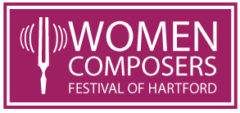Friday, March 6 | 2:00-3:30 pm
Charter Oak Cultural Center
21 Charter Oak Avenue
Hartford, CT 06106
Purchase Tickets
Sarah Masterson, “Florence Price’s Sonata in E minor”
In this lecture recital, Dr. Masterson will discuss and perform Florence Price’s Sonata in e minor. Despite the popularity of her works during her lifetime, her piano compositions are relatively unknown today.
During the first half of the twentieth century, a number of African-American women composers lived and composed in Chicago. At that time, Chicago’s African-American community had a significant number of musical organizations with very high standards. By 1905, this community featured twenty-one music teachers, four bands and orchestras, five concert companies, and four musical organizations. In 1914, William Henry Hackney produced the first concert of music composed entirely by African-American composers in Orchestra Hall. By the time Florence Price moved to Chicago in 1926, this musical community was flourishing. Having trained at respected institutions such as the New England Conservatory, Price had already established her teaching career; however, it was in Chicago that she achieved national and international recognition for her compositions. Along with her first symphony, Sonata in e minor won honors in the 1932 Rodman Wanamaker competition. The following year, her Symphony in E Minor was performed at the Chicago World’s Fair and broadcast over radio, bringing her music international exposure. The success of the symphony and piano sonata launched Price’s quite successful composing career.
In her large-scale works, Price’s musical language typically stays within a conservative, neo- Romantic style, while still reflecting her cultural heritage. In Sonata in e minor, the influence of spirituals and dance music can be heard throughout the piece, although direct quotations are avoided. In this work, Price unites her thorough knowledge of classical traditions with a uniquely American sound.
Joann Kirchner, “Four-Handed Literature by Women Composers”
Piano duets have a long and rich history. The first public piano duet took place in 1765, when Mozart performed with his sister, Nannerl. Mozart later wrote to his father that he was including piano duets in his teaching. Beethoven encouraged Czerny, who was teaching his nephew Karl, to include duets as part of his practicing. Duets were published almost as frequently as piano solos during the first 75 years of music publishing.
The benefits of playing duets are varied. Participants experience great satisfaction from being able to put the two parts together successfully. The social interaction and companionship is often times fun and rewarding and players are motivated to play their very best. From a pedagogical perspective, musicianship skills are enhanced through listening, analyzing and discussing the score. In addition, sight-reading is greatly enhanced, along with score reading.
The body of four-handed literature written by women composers has often been overlooked. In an attempt to promote the contributions of women composers, both past and present, we will present piano duets down through the centuries, beginning from 1823 and concluding with 2004. It is our hope that in communicating this genre of music that we will inspire teachers to incorporate some of this music into their teaching studios and perhaps encourage performers to program more literature by women composers. The input of these women constitute a body of literature that should be explored in greater detail and accorded a prominent place in both standard teaching literature and concert programming.
In the words of Schumann, taken from his Eighty-Eight Rules for Young Beginners, “one should never miss the opportunity to play duets.”
Feminine Musique: Tammy Hensrud, mezzo; Korliss Uecker, soprano, “Songs of Sassiness and Spirit”
“Songs of Sassiness and Spirit” presents lighter fare of some primarily American Women Composers from this century. There are jazz influences, dance influences and cabaret influences throughout this program. We will be including cabaret songs by Mira Spektor. Beth Andersonʼs Duet song cycle, Dark Songs, has lighter moments of “randy suggestiveness” or asks for a sense of “violent desolation” along with rhythmic, jazzy accompaniment. DeKenesseyʼs Cabaret song cycle, Well Tempered Woman, touches on those phases of life as a woman; the ones we speak about and those we do not. From depilatory woes comically expressed in Like a Chicken to the balancing act of being a wife, working woman and sexy female in At Night, to the painful expression of losing a Mother to Alzheimerʼs in Mother, Where have you gone, DeKenessey brings us from smiles to tears. (The Duet version of these songs was composed by Ms. DeKenessey explicitly for Feminine Musique.) While most of Rebecca Clarkeʼs songs were lighter in nature, her 1933 Tiger, Tiger, a setting of Blake’s poem “The Tyger”, is dark and brooding, almost expressionist and seemed a fitting addition to this program. She worked on it for five years to the exclusion of other works during her tumultuous relationship with John Goss and revised it in 1972. Finally, Libby Larsenʼs wonderful song cycle ME treats Brenda Uelandʼs poetry as an evolving modern day “Frauenlieben und Leben” with the movements we have chosen to be the pillars of oneʼs life with a little fun in between.
